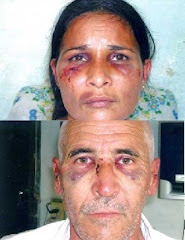Tough Times in Cuba's Prisons
Former inmates describe abuse by warders as well as poor health,
sanitation and nutrition.
Former political prisoners in Cuba say conditions in jail are poor and
inmates are often subject to abuse.
Official data from 2012 showed Cuba with a prison population of 57,300,
or 508 per 100,000 people. A study by the International Centre for
Prison Studies at Essex University indicated that Cuba had the world's
sixth highest prison population, based on a 2013 rate of 510 per 100,000
in the world.
The figures are disputed by the Cuban Commission for Human Rights and
National Reconciliation (CCDHRN), whose head Elizardo Sánchez Santa Cruz
has been investigating convict numbers. Sánchez estimates the prison
population at up to 70,000.
Video:
https://youtu.be/Gz2xQ-Tvhus
"Cuba is literally a huge penitentiary centre," the Cuban Human Rights
Observatory, headquartered in Madrid, says. "Half a century on, there
are around 200 prisons for 11 million citizens. The population has
multiplied by two, but prisons have multiplied by a factor of 14."
Using the government total of 200 prisons – excluding juvenile detention
centres – Cuba now has one prison for every 56,000 people, compared with
one per 422,000 people in 1959, the year the Cuban Revolution took place.
The government says that reoffending rates are low and that half of all
prisoners are able to do paid work, study, or learn a trade while they
are on the inside.
In 2013the government provided a highly orchestrated "conducted tour" of
four prisons for foreign journalists. (See Cuba Grants Prison Access on
Own Terms.) Speaking at the time, Major Jorge Fonseca, the governor of
La Lima prison, said the policy was to shift low-risk convicts who
behaved well to the growing number of minimum-security facilities.
People locked up for their political beliefs say conditions are very far
from the ideal the government tried to show in 2013.
Marcelino Abreu Bonora, a former prisoner, said he was held in buildings
where water leaked through into the cells, "politicals" like him were
only allowed out to exercise for four or five minutes a day, and the
main daily meal consisted of minced fish full of bones.
"There are some places in the prison where you just can't sleep –
leaking roofs, ceilings falling in, 50 or 60 people to a small cell," he
said.
Opposition sources say government of glossing over the overcrowding,
poor nutrition, water shortages and limited exercise periods. Inmates
are able to alleviate their hunger with food parcels which relatives are
allowed to bring every six weeks.
The authorities have increased the number of jails by converting
schools. These include a secondary school in the town of Juraguá,
Cienfuegos province, and two in a rural area of Motembo, Villa Clara
province.
The Juraguá facility now holds 500 inmates from the bigger Ariza prison.
They are employed in charcoal production.
Lázaro Yosvani Montesino Hernández spent time making charcoal after he
was jailed in 2003 for taking part in an opposition event in Havana.
After the Güira de Melena prison, where he was tasked with cutting down
timber for commercial use, he was transferred to a jail in Matanzas
province, and employed to cut down trees to make charcoal – with no
safety regulations or basic working conditions.
In the accompanying film, former inmates talk more about conditions and
abuse at the hands of warders.
Arián Guerra Pérez is a Cuban journalist.
Source: Tough Times in Cuba's Prisons | IWPR -
https://iwpr.net/global-voices/tough-times-cubas-prisons-0
Subscribe to:
Post Comments (Atom)

No comments:
Post a Comment